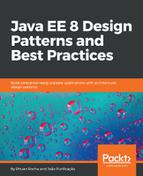In Chapter 7, Microservice Patterns, we explored the reactive programming paradigm and how it is implemented using Java EE 8 mechanisms. We also demonstrated how we can make asynchronous calls using Java EE 8 mechanisms, and how to control these calls and apply actions to them via asynchronous processing.
Event in CDI is a mechanism of the CDI specification that can be used in all tiers of an application. However, using this mechanism is recommended when working with a presentation tier. This is because CDI has a major focus on the presentation tier and its scopes are directly related to the HTTP interaction and HTTP session. Furthermore, we could launch an event with various elements that react to this event.
The asynchronous EJB method doesn't use the reactive programming paradigm but is an asynchronous process that makes it possible to decrease the time it takes to respond to the client. This is an EJB mechanism and it is recommended to use it at the business tier. The benefit of using this mechanism is that we can also use other EJB mechanisms, such as the transactions control.
The asynchronous REST service is a mechanism of the JAX-RS specification that is able to create a REST service that can do asynchronous processing. With this mechanism, the control of the process is returned as soon as a request is sent, and the client, therefore, doesn't need to wait a long time to process other tasks. This mechanism is always implemented in the presentation tier.
In the next chapter, we will cover microservice patterns and how to implement them. We will also look at the aggregator pattern, proxy pattern, chained pattern, branch pattern, and asynchronous messaging pattern.
